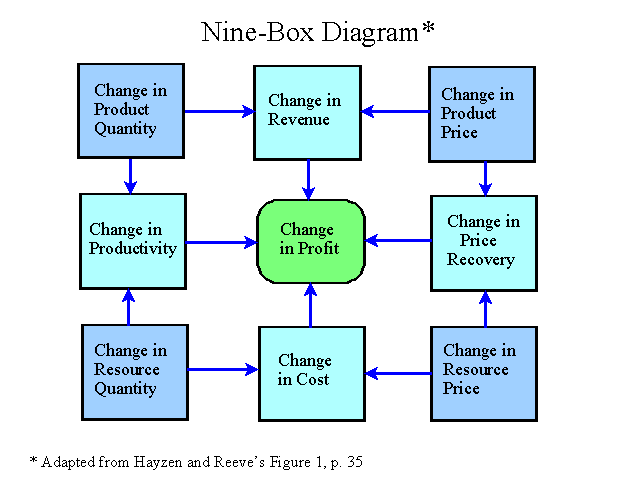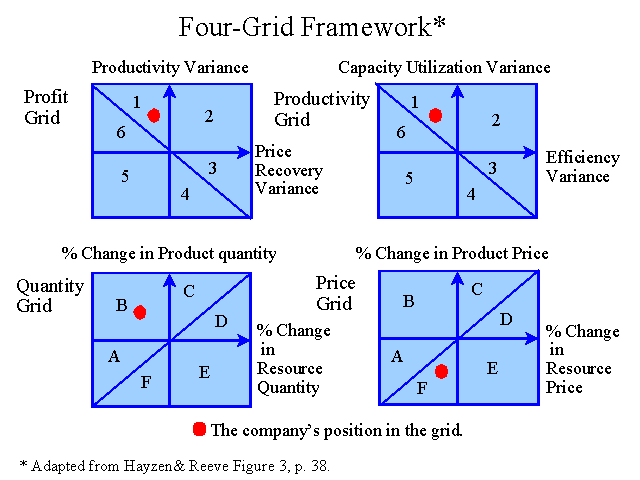
Summary by Scott Ingram
Master of Accountancy Program
University of South Florida, Summer 2003
Productivity Main Page |
Profit Analysis Main Page
Most businesses today focus on the attainment and maintenance of a desired level of profit.The authors believe that it is equally important to understand the drivers for changes in profits. The purpose of this article is to provide a framework that can be used to assess the profit-generating ability of a company by focusing on change in profit rather than on static profit levels.
The framework used in this article is called “productivity accounting” by the authors. Since productivity is a measure of an organization’s ability to convert labor, capital and materials into finished goods and services, it has a very strong correlation with profitability. This approach measures the change in total resource productivity and the effects of these changes on the corresponding change in business profitability.
The change in profit is described as the sum of two elements: the change in productivity and the change in price recovery. Productivity is defined as the ability to turn inputs into outputs. Price recovery is defined as a firm’s ability to capture value it creates through pricing power. The formulas that depict these relationships are as follows:
Change in Profit = Change in Productivity + Change in Price Recovery
Productivity = Product Quantity (output quantity) ÷ Resource Quantity (input quantity)
Price Recovery = Product Price (output price) ÷ Resource Price (input price)
Traditional Measures vs. Productivity Accounting
Productivity accounting decomposes these two sources of economic competitiveness, productivity and price recovery, to guide the overall strategy of the firm. Unfortunately, many traditional business performance indicators, such as ‘sales per square yard’, give conflicting signals because they do not isolate productivity from price recovery effects.
The following is an adaptation of Table 1:
| 1998 | 1999 | |||||
| Value | Quantity | Price | Value | Quantity | Price | |
| Sales | $99 | 11 units | $9 | $110 | 11 units | $10 |
| Rent | 52 | 26 sq yards | 2 | 78 | 26 sq yards | 3 |
| Profit | $47 | $32 | ||||
| Sales per sq yard | $99/26 =3.8 | $110/26 = 4.2 | ||||
| Productivity | 11 units/26 = 0.42 | 11 units/26 = 0.42 | ||||
In the above example, the profit and productivity measures correctly show that profits have decreased from 1998 to 1999 while productivity has remained constant. The ‘sales per square yard’ measure incorrectly indicates that business has improved because revenue is in the numerator. Though revenue is a much used traditional measure, it is comprised of both a productivity and a price effect.
Graphical Analysis
The authors use a “nine-box diagram” to depict the enhancement of conventional profit analysis through a function of changes in productivity and changes in price recovery.

In order to easily interpret a productivity accounting analysis for a business, the results should be presented in a visual form. The authors recommend a four grid presentation, with one grid for each of the following: Profit, Productivity, Quantity and Price as illustrated below.

Each grid shows how the organization is performing on that particular measure. These grids, when viewed together, show the organization’s profitability and its different drivers. This information can be used to monitor performance and profits, evaluate business profit plans and measure an organization’s position relative to its competitors. For example, the profit grid in the illustration above shows that the company's increase in profit was caused by an increase in productivity, but this was reduced by price under-recovery. The productivity grid shows the increase in productivity was driven by in increase in capacity utilization, but this was reduced by a decrease in efficiency. The quantity grid indicates that the company increased production while reducing resource usage. Finally, the price grid indicates the source of the price under-recovery indicated in the profit grid. The decreases in product prices were greater than the decreases in resource prices.
Summary
Corporations or business units can analyze changes in profit in terms of a change in productivity and a change in price recovery. The authors present the following summary statements, with the assumption that all other factors are held constant:
1. Productivity improvement will translate directly into profit improvement.
2. Price over-recovery will translate directly into increased profits in the shortterm.
3. Price under-recovery translates directly into a decrease in profits in the short term.
____________________________________________
Related summaries:
Dehning, B., K. E. Dow and T. Stratopoulos. 2003. The Info-Tech "productivity paradox" dissected and tested. Management Accounting Quarterly (Fall): 31-39. (Summary).
Hammer, M. 1990. Reengineering work: Don't automate, obliterate. Harvard Business Review (July-August): 104-112. (Summary).
Hammer, M. 2001. The superefficient company. Harvard Business Review (September): 82-91. (Summary).
Hammer, M. 2007. The process audit. Harvard Business Review (April): 111-123. (Note).